Arriving like a rogue wave, a giant dust storm enveloped our campsite during the middle of the night en route to San Juan – a 160 kilometer stretch of desert in a region somehow described without irony as “the fertile valley.â€�  True, mountains rise up on both sides making it a valley, but exactly what is considered fertile in this windswept scrub covered region has been lost on us. Â
              Disaster seemed to blow in with the dust, knocking all three bikes to the ground and scattering our stuff across the desert.  Everything coated with a fine layer of sand to be dusted off before a daylong struggle against the headwind.

Morale seems to take the brunt of the wind, which seems to offer very little in favor of the bike tourist.  At the end of a long hour against the wind, there is no vista, other than the dusty, almost apocalyptic horizon, that you have seen throughout the day.  Time slows, and kilometers grow longer.
              Though we have largely passed the most brutal aspects (high elevation, and epic 4,000m ascents) of the Andes, our path brings us new challenges we have not had to consider for years.  Since southern Mexico, we have had very few nights where we could sleep out under the stars without expecting a rain shower.  Somewhere in Bolivia, I remember looking up the night sky, strange and unfamiliar, no big dipper, no orion´s belt. Though I had been in the southern hemisphere for months, it seems that not until we reached the arid altiplano, did the cloud cover vanish and the sky opened up.
              Bolivia was a lonely country, outside the few big cities.  Every town we passed through seemed like a ghost town, doors of vacant houses in their town squares flapping in the wind.  If a tienda existed, we almost certainly had to track down the owner so we could buy what little provisions they could offer, from canned peaches to llama jerky.  In between the towns, we´d pass herds of llamas (vicuñas, and alpacas) attended by pair of children tailing the animals, throwing rocks to keep them moving. Sometimes, an elderly woman or man would accompany the herd, wandering languidly beside them in often isolated areas, sometimes a days hike to any kind of village.  Much of the Bolivia we passed through was unsuitable for any kind of crops, even quinoa, which seems to miraculously grow in the harshest conditions.  Llamas become a tremendously important resource, it´s meat used for food, it´s milk for cheese, and it´s wool for clothing.  I hoped that some of the Bolivians I saw, resting against a dirt mound chewing coca leaves had found some peace in living so connected to their environment, in such a lonely country.
              Crossing into Argentina has been an eye opening experience.  No longer do we overhear the word “gringoâ€� whispered and shared as we pass through town.  While indigenous populations make a majority of the population in Bolivia, fair skinned Argentinians are quite common.  For a bathroom, no longer do we see the cement footprints in front of a hole, rather, even in rural areas there is a ceramic toilet complete with a bidet at its side. Â
              At a gas station, we asked if the water from the faucet was drinkable. “No, there is too much chlorine.� he said and pointed to the steamer on the espresso machine which had some mineral buildup. In stark contrast to the previous two years of traveling where the water would make you ill, not to mention the fact that espresso machines didn´t exist outside the bigger cities in Bolivia, and here we were at some gas station out in the middle of Argentina nowhere, and we could order a double latte to go.
              We stopped for lunch one day at a wide open field with more grass than we had seen in all of Bolivia.  A polo tournament was going on and the leisure class was sitting under umbrellas drinking wine and laughing as the riders galloped past.  I noticed a few high school kids kicking around a soccer ball, they were both wearing a type of slipper, reminding me of something I was once told, “that you can tell a lot by the shoes a man wears.�  It seemed like just yesterday, we were watching some kids play soccer on a field of dirt, a dust cloud following the movements of the game, with the players all barefoot or in shoes with soles flapping with each step.
              We have now crossed far below the Tropic of Capricorn, and dark green parrots remain the last vestige of the tropics, chatting noisily in the trees.  As we travel further into the southern hemisphere, we start to encounter regions that remind us of somewhere up north, memories of sections in Canada become fresh and remind us that we are nearing the end of this journey.    Â
Recently, along the route 40 we´ve been riding, that traverses Argentina, a family of gypsies in two overfilled trucks has been playing leapfrog with us. We had been seeing them alongside the road searching for scrap wood or camped out on the outskirts of town cooking dinner, smoke rising up through the thorn trees.   One day when I was cycling past, one of the naked, dirt covered kids tried to throw a rock at me with a great big smile on his face so I stopped to talk to them and find out what their story was. They told me that their olive orchard died from some disease and they lost everything they had.   We have been pedaling through so many dust storms, I couldn´t help but imagine them as American okies, trying to escape the dust bowl. Now they are wandering the 40, making furniture out of wood they find and selling it in the towns they come across. When I asked them where they were ultimately headed, they looked at me, somewhat forlorn for a moment, and said, “We don´t know.â€�           Â
                                                                Â
I imagine the parrots will soon disappear as we move further south, the arid terrain will once again be replenished with water and the valleys will be fertile.  The Andes will taper off and the horizon will expand, as we continue to keep the afternoon sun on our right.  In a few months, we will be arriving in Tierra del Fuego, and memories of our first days on the bike in Alaska will come back again, and like the parrots, will remind us of what an incredible journey it has been.
Â

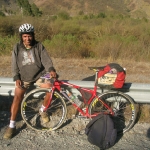
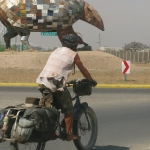
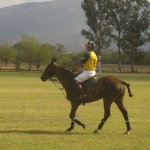
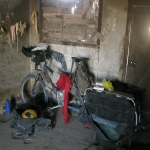
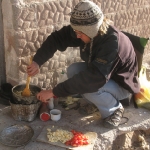
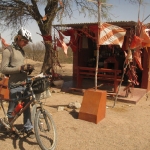
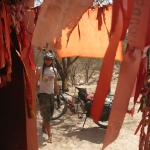
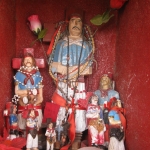
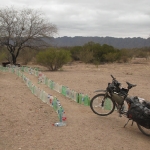
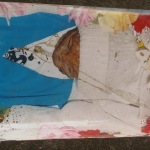
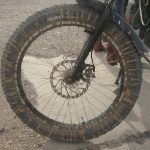
Great post. The best one so far…and I haven’t even looked at the pics yet.
Great post. The best one so far…and I haven’t even looked at the pics yet.
Great post. The best one so far…and I haven’t even looked at the pics yet.
Very interesting. WOULD like a little explanation on some of the photos though.
Very interesting. WOULD like a little explanation on some of the photos though.
Very interesting. WOULD like a little explanation on some of the photos though.
Thanks for sharing!!
Thanks for sharing!!
Thanks for sharing!!
EPIC!!!
EPIC!!!
EPIC!!!
I enjoyed this! Well done!
I enjoyed this! Well done!
I enjoyed this! Well done!
the pics are a little obscure l suppose…
argentine cycle tourist
on old time-trial bike with only one brake
whom we encountered en route
goat in front of scrapmetal armadillo
aformentioned polo player
seans bike inside an abandoned building in which we were camped to avoid the windstorm outside
sean the master chef
shrine to gauchito gill
we dotn know any thing about him , but he seemes much loved
red flags and shrines abound
goat at a shrine (nice places to rest: sun/wind shelter often tables and such)
gauchito gill him self (three of him that is – gauchito means “little cowboy”
water bottles leading to a “difunta corea” shrine
water left as offerings and succor to thursty travelers (we avail our selves often)
¿? found at “senor de la puntita” shrine
chocolate accident turned modern art
purty eh
(hi dougie)
the pics are a little obscure l suppose…
argentine cycle tourist
on old time-trial bike with only one brake
whom we encountered en route
goat in front of scrapmetal armadillo
aformentioned polo player
seans bike inside an abandoned building in which we were camped to avoid the windstorm outside
sean the master chef
shrine to gauchito gill
we dotn know any thing about him , but he seemes much loved
red flags and shrines abound
goat at a shrine (nice places to rest: sun/wind shelter often tables and such)
gauchito gill him self (three of him that is – gauchito means “little cowboy”
water bottles leading to a “difunta corea” shrine
water left as offerings and succor to thursty travelers (we avail our selves often)
¿? found at “senor de la puntita” shrine
chocolate accident turned modern art
purty eh
(hi dougie)
the pics are a little obscure l suppose…
argentine cycle tourist
on old time-trial bike with only one brake
whom we encountered en route
goat in front of scrapmetal armadillo
aformentioned polo player
seans bike inside an abandoned building in which we were camped to avoid the windstorm outside
sean the master chef
shrine to gauchito gill
we dotn know any thing about him , but he seemes much loved
red flags and shrines abound
goat at a shrine (nice places to rest: sun/wind shelter often tables and such)
gauchito gill him self (three of him that is – gauchito means “little cowboy”
water bottles leading to a “difunta corea” shrine
water left as offerings and succor to thursty travelers (we avail our selves often)
¿? found at “senor de la puntita” shrine
chocolate accident turned modern art
purty eh
(hi dougie)